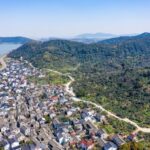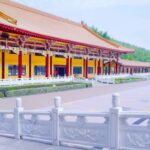The Xinchang Grand Buddha Temple Scenic Area is located on the side of Nanming Mountain and is close to Xinchang County. It is not just an ordinary millennium-old temple in the usual sense, but a large, well-developed tourist area. In addition to the Maitreya statue and the five-story-high Grand Buddha Hall, there are also more than ten scenic spots such as the Dinosaur Park of Wood Fossils, Shuanglin Grottoes, and Shooting Eagle Village, with rich landscapes. Not far ahead from the scenic area entrance, there is a fork on the right leading to Shooting Eagle Village. The buildings in the village are arranged according to the scenes in ‘The Legend of the Condor Heroes’. You can walk into Niujia Village, the hometown of Yang Tiexin, Guiyun Manor of Lu Chengfeng, and Xuanyuan Terrace of the Beggar Gang to relive the plots in the book. To the north of Shooting Eagle Village is the Dinosaur Park of Wood Fossils. The tree age of this forest of wood fossils (silicified wood) is over 100 million years. Nowadays, traces of being struck by lightning and eaten by insects can still be clearly seen. It is a precious paleontological relic in Xinchang and is well worth seeing. Walking towards Mingjing Lake from here, continue to visit Shuanglin Grottoes. This grotto is also newly built and is on the cliff on the mountainside. Ascending the steps, there are huge reliefs of the two generals Heng and Ha on the cliff. Inside the grotto of the Reclining Buddha Hall is a reclining Buddha with a serene expression. The ceiling of the surrounding hall is covered with intricate reliefs, which are very exquisite. Shuanglin Grottoes has a small platform with stone benches for rest. From here, overlooking Mingjing Lake below and looking afar at the Grand Buddha Hall, the view is wide open. On the tourist trail, from a distance, you can see a smiling Maitreya stone statue among the green trees in the mountains. If you walk nearby, you will find that on one side of the open-air Maitreya, there are also six small stone-carved Maitreyas with different shapes. Many tourists like to take pictures here. The nearby Five Hundred Arhats Cave can also be visited. In the farther place on the right are scenic spots such as Qiguang Jingyuan, Banruo Valley, and Kṣitigarbha Hall. You can walk all the way there, circle around to the classic Grand Buddha Hall, or directly climb up from the main road in the middle for a shorter distance. Amazingly, the five-story wooden structure on the outside and the grotto inside are perfectly integrated. Inside, there is a stone Maitreya statue as high as 16 meters. The statue was carved in the Southern Dynasties and is resplendent. It is an early grotto Buddha in the south of the Yangtze River and is known as the ‘First Grand Buddha in Jiangnan’, which is 200 years earlier than Leshan Giant Buddha in Sichuan. Beside the release pond next to the Grand Buddha Hall is the commemorative tower of Master Zhizhe, which was built in the Sui Dynasty. To the northwest of the Grand Buddha Temple, there is also the Thousand Buddha Temple, which has more than a thousand vivid small Buddha statues. Its history is even longer than that of the Grand Buddha. Baiyun Mountain Villa at the entrance of the scenic area is one of the good local hotels. You can consider staying here. The standard room is around three to four hundred yuan. Opening hours: Open from 06:00 to 17:30 from May 1st to September 30th; open from 06:00 to 17:00 from October 1st to April 30th. Preferential policies for children: 1.
Free admission for children under 2 meters (inclusive); discounted tickets for children between 1.2 meters (exclusive) and 1.5 meters (exclusive). Elderly: Free admission for those aged 70 (inclusive) and above with valid ID; discounted tickets for those aged 60 (inclusive) to 69 (inclusive) with valid ID. Students: Discounted tickets for minors aged 6 (exclusive) to 18 (exclusive) and full-time undergraduate students and below with student ID and ID card. Disabled: Free admission with valid certificates. Active military personnel: Free admission with valid certificates. Shaoxing citizens: Free admission for Shaoxing citizens with ID during non-holiday periods (local citizens still need to buy tickets normally during the golden weeks (Spring Festival, National Day) and short holidays (New Year’s Day, Qingming, Labor Day, Dragon Boat Festival, Mid-Autumn Festival)). Additional information: The above information is for reference only, and the actual situation at the scenic spot shall prevail. Service facilities: Parking lot: [Xinchang Dafo Temple Parking Lot] Reference price: ¥30 per time; Address: Entrance of Dafo Temple Scenic Area; Spaces: 400; Small vehicles ¥20 per time, large vehicles ¥30 per time. Nursing room: Address: The third restroom in the scenic area.









